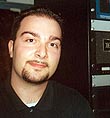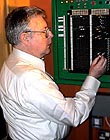|
|
This topic comprises 2 pages: 1 2
|
|
Author
|
Topic: Xenon exhaust cooling air
|
|
|
|
|
|
|
John Pytlak
Film God

Posts: 9987
From: Rochester, NY 14650-1922
Registered: Jan 2000
|
 posted 12-10-2001 03:28 PM
posted 12-10-2001 03:28 PM





If you smell the pungent odor of ozone, you should definitely vent to the outside. Some building codes may mandate it!Even if the ozone levels are very low, some people are very sensitive to the smell, which may cause headaches, itching red eyes, or nausea in some individuals. AFAIK, limits for ozone exposure are 0.1 parts per million TLV-TWA. Here are some links:
http://www.inusacorp.com/applications.cfm#
http://www.osha-slc.gov/dts/chemicalsampling/data/CH_259300.html ------------------
John P. Pytlak, Senior Technical Specialist
Worldwide Technical Services, Entertainment Imaging
Research Labs, Building 69, Room 7525A
Rochester, New York, 14650-1922 USA
Tel: 716-477-5325 Cell: 716-781-4036 Fax: 716-722-7243
E-Mail: john.pytlak@kodak.com
Web site: http://www.kodak.com/go/motion
| IP: Logged
|
|
|
|
|
|
|
|
|
|
|
|
|
|
|
|
Brian Vita
Film Handler
Posts: 8
From: Peabody, MA, USA
Registered: Mar 2000
|
 posted 12-26-2001 08:17 AM
posted 12-26-2001 08:17 AM





I've never seen a building code that specifically allowed you to dump exhaust air into the ceiling. Codes either specifically say that lamphouse exhaust must be exhausted from the building or they do not address it at all.The ceiling dump method, while of questionable merits, is usually allowed by omission or by the ignorance of the inspector (ie. it goes through the ceiling therefore it must go out logic). It is my understanding that ozone poisoning is somewhat like carbon monoxide poisoning in its symptoms. You sometimes get drowsy, light headed or head achey. Many years ago a good friend of mine had a heart attack in a xenon booth. I noticed when I worked that booth I frequently got very drowsy. I often wondered.
------------------
Cinema Service & Supply, Inc. has a full line of new and used cinema equipment. We provide service throughout North America.
Brian Vita, President
Cinema Service & Supply, Inc.
75 Walnut St., Peabody, MA 01960-5626 USA
(800)231-8849/Fax(800)329-2775
+1-978-538-7575/Fax +1-978-538-7550
sales@cssinc.com /www.cssinc.com
| IP: Logged
|
|
Jerry Chase
Phenomenal Film Handler

Posts: 1068
From: Margate, FL, USA
Registered: Nov 2000
|
 posted 12-26-2001 11:42 AM
posted 12-26-2001 11:42 AM




"Another disadvantage of venting directly to the projection room is that you are adding to the heat load. Most of the energy consumed by a xenon lamp ends up as HEAT, and kilowatts add up quickly in a multiplex. The heat usually causes a significant decrease in the relative humidity, which will aggravate static problems and film curl."While factually correct, I'm fairly sure this is incorrect in the inferred conclusion (That vented booths will have higher RH than unvented booths). Venting heated air into the same room will not adversely affect actual humidity. The same air (and moisture) are recycled. Moisture doesn't disappear, it only moves or changes state. As the temperature increases, there is a small decrease in the _actual_ humidity. This decrease is in direct relation to the expansion of the air, which will force a small amount of the air out of the booth. Example: Given a volume of ten thousand cubic feet of air, a temperature rise from 70 degrees to 80 degrees F will expand to 10K(460+80)/(460+70), or 10,189 ft^3. Therefore, since a booth can't expand, 189 ft^3 of air flows out during the time of the temperature rise. This is a relatively insignificant amount of air and moisture loss. The relative humidity DOES drop, since hot air is capable of "holding" much more moisture than cold air. About five quarts of water are in this same volume of air at 50% RH at 70 degrees. More moisture can easily be added to the booth by ducting this exhaust air from each lamp into the intake of a room humidifier. Since humidification requires energy to convert liquid water into vapor, it cools the air. This has the added benefit of slowing the booth temperature rise while increasing relative humidity. In addition, any stray ozone will become entrapped in the moisture pad and serve to sanitize the water in the humidifier. Constantly venting the booth is much more of a problematic, since large volumes of air are extracted and the heat (and moisture) in that air is lost to the theatre (look at the CFM rating of any xenon lamphouse fan, and multiply that by the number of lamphouses to see the seriousness of the issue). That air has to be replaced by air from the general building or HVAC, and ultimately, the cold exterior air. During winter operation, this heated air can be incredibly dry. The air coming in from outside, if it is at 32 degrees F, is only capable of "holding" a little more than a quart of water in the same 10K ^ft., and usually holds much less water than that. Literally, to maintain a 50% RH in our hypothetical booth with one complete change of air, the energy required to boil at least a gallon of water into vapor has to be added to the energy required to heat the air from 0 degrees to 70 degrees. In cold climates, the heating requirements and codes dictate a certain amount of fresh air exchange per person, based upon a full auditorium load, and the incoming booth replacement air effectively has no RH when heated. I have yet to see a theatre that properly maintains a 50% RH under these conditions. Unless air coming into the booth to make-up for the exhaust air is specifically humidified in the duct, and the booth held at a slight positive pressure, the booth suffers from low humidity as well. In summary, I think that humidity problems in the booth are much better addressed during winter operation by primarily venting the lamphouse into booth humidifiers, reducing the overall energy requirements of the building. During summer operation, most of these vents can be switched to outside exhaust to reduce excessive heat and humidity buildup. Use of a "T" or "Y" connection and (motorized or manual) dampers could make this a simple operation that allows much more control over the booth "climate." If this system were coupled to an energy management computer, the entire booth could easily be maintained at 50% RH most of the time while substantially reducing heating costs, by minimizing the loss of heated moisture laden air to the exterior.
| IP: Logged
|
|
|
|
Jerry Chase
Phenomenal Film Handler

Posts: 1068
From: Margate, FL, USA
Registered: Nov 2000
|
 posted 12-27-2001 03:13 PM
posted 12-27-2001 03:13 PM




The problem with many heat exchangers is that the humidity is not maintained. Air flowing in is warmed by air flowing out, allowing a 50% efficiency gain in totally dry air, but since the exiting moist air contains more energy than the dry income air, this efficiency is never attained.There are recovery wheels Link that retain most of the moisture. Ozone can be removed through use of catalysts or activated charcoal filters. Again, air going through a humidifier pad would lose substantial amounts of ozone to the water. Trying to duct incoming air to the lamphouse can be like herding cats; many lamphouses have multiple incoming air paths and require specific flow patterns. Lamphouse exhaust considerations should, IMO, be re-evaluated now that carbon arcs are rarely used and bulb manaufacturers are reducing the amount of ozone generated, as Gordon mentioned.
| IP: Logged
|
|
|
|
All times are Central (GMT -6:00)
|
This topic comprises 2 pages: 1 2
|
Powered by Infopop Corporation
UBB.classicTM
6.3.1.2
The Film-Tech Forums are designed for various members related to the cinema industry to express their opinions, viewpoints and testimonials on various products, services and events based upon speculation, personal knowledge and factual information through use, therefore all views represented here allow no liability upon the publishers of this web site and the owners of said views assume no liability for any ill will resulting from these postings. The posts made here are for educational as well as entertainment purposes and as such anyone viewing this portion of the website must accept these views as statements of the author of that opinion
and agrees to release the authors from any and all liability.
|

 Home
Home
 Products
Products
 Store
Store
 Forum
Forum
 Warehouse
Warehouse
 Contact Us
Contact Us




 Printer-friendly view of this topic
Printer-friendly view of this topic

















